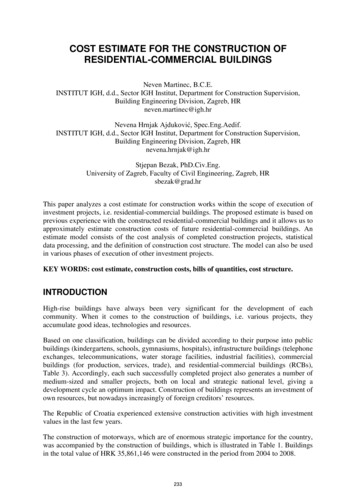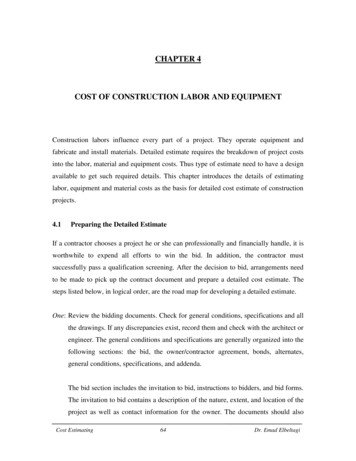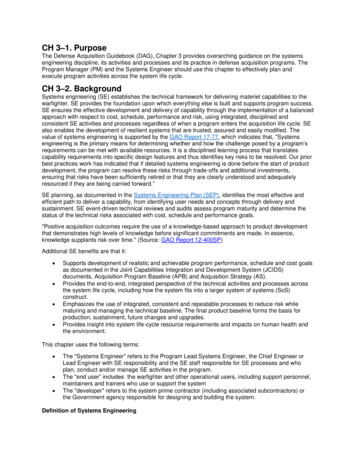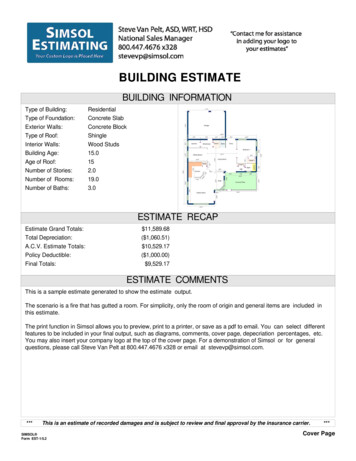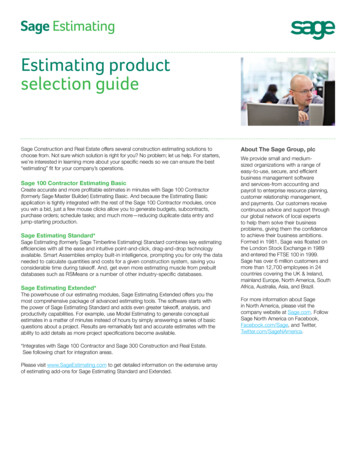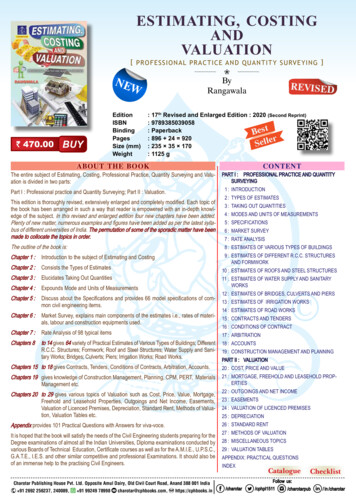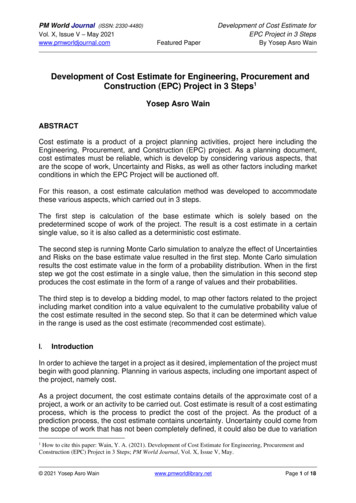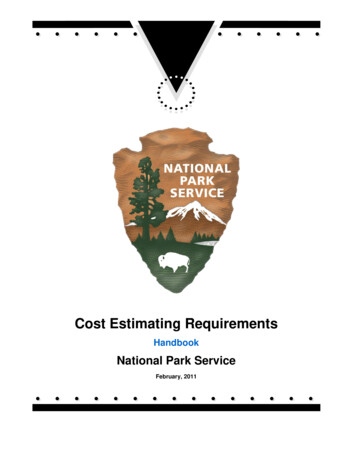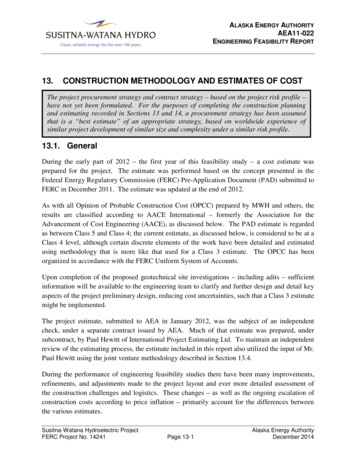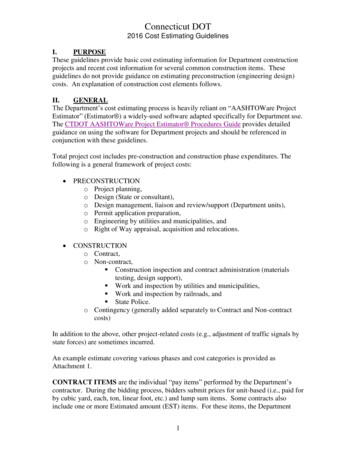
Transcription
How to Estimate the Cost of HIGHRISE CAST IN PLACE FLAT SLAB CONSTRUCTIONPeter M HamiltonJuly 2015
Peter Hamilton is a Senior Estimator for Tutor Perini Building Corp in New York City. Peter’s passionfor buildings began at a young age and led to pursuing and receiving a Bachelor of Architecture from theNew Jersey Institute of Technology. While studying architecture, Peter found interest in construction anddetailing which led to furthering his education and receiving a Masters of Civil Engineering from the NewJersey Institute of Technology. His career in construction began as an onsite project engineer for a newcollege gymnasium and field complex. This led to being an assistant project manager for a new stadiumfor the New York Red Bull which gave him the insight to the preconstruction and estimating rolesthrough procurement and change order estimating. Today Peter has focused his estimating career on highrise residential and hospitality projects with a focus on concrete systems, exterior enclosures, interiors andnew technologies and construction methods.
How to Estimate the Cost of HIGHRISE CAST IN PLACE FLAT SLAB CONSTRUCTIONCandidate Number: 0115820July 2015Page 1 of 13
TABLE OF CONTENTSIntroductiona. Main CSI Divisionb. Specific Sub-DivisionPage 3Types and Methods of MeasurementsPage 4Specific Factors to Consider Affecting Takeoff and Pricinga. Small Quantities vs. Large Quantitiesb. Geographical Locationc. Seasonal Effect on WorkPage 7Overview of Labor, Material, Equipment, Indirect Costs, Approach to Mark UpsPage 9Special Risk FactorsPage 13Ratios and AnalysisPage 13Samples Sketchesa. Story Poleb. TakeoffsPage 14Sample Takeoff and Pricing Sheeta. Sample Takeoff Calculationsb. Estimate Takeoff Calculationsc. Pricing SheetPage 19Page 2 of 13
IntroductionFlat slab cast in place concrete is one of the most important systems a core and shell estimatormust complete for a high rise building. Often equated to the bones of a building, flat slab concretesystems are the structural system of the building. Through this technical paper, a process for estimating ahigh-rise flat slab cast in place concrete structures will be presented from the perspective of a GeneralContractor. This process is intended to provide insight to show one of the many methods for estimating atypical floor which can be extrapolated into a full structural CIP concrete estimate. It is intended at thecompletion for the estimator to have an outline for identifying the typical floors used for takeoffs and anunderstanding how to establish a cost estimate for the typical CIP concrete structure based on location andspecific construction methods.High rise, also known as towers or skyscrapers, or a tall building, can be looked at in four distinctzones: the foundations, basement, Podium, Tower. This technical paper will focus on discussingestimating the elements in the Tower zone which can be a single or multiple repetitive floor plans. FlatSlab Concrete is a structural system used to minimize beams and column capitals. In towers withrepetitive floors, minimizing the additional material and labor required for work at beams and columnsprovides a real impact on savings both in schedule and cost. This method of construction is best suited forhotel and residential buildings which have a lower floor to floor height and unit layouts which arerepeated.Master Format 2014Main CSI Division - 03 00 00 ConcreteSub Divisions03 10 00 Concrete Forming and Accessories03 20 00 Concrete Reinforcing03 30 00 Cast-In-Place ConcretePage 3 of 13
Types and Methods of MeasurementsTake Off QuantitiesConcrete is taken off by the four elements that make up the structure. These elements areColumns, Walls, beams, and decks. The materials that are taken off which make up these elements are therebar, formwork, concrete material, and finishing area. These materials use the following take off units inan estimate:Rebar - pounds or tonsConcrete Material - Cubic YardsFormwork - Square Footage - contact area of formFinishing - Square Footage - Surface areaHigh-rise Concrete buildings present a lot of unique take offs and if not broken down, elementscan be missed or over estimated. The first step in estimating a high-rise concrete building is to start byunderstanding the overall shape and height for each floor and create a matrix with this information, alsoknown as a story pole. Next, once all the floors are reviewed, areas of the building are defined for nontypical (Podium and basement) and typical. Non Typical are those floors and areas which have norepetition between each floor. Each floor in the non-typical will be looked at on an individual basis.Typical floors are those floors which are identical. Identical floors for the purpose of estimating are thosefloors which have the same height (Floor to Floor), same plan footprint (edge of slab, column sizes, corewall thickness and shape), and which use the same materials. Lastly, this information is used to takeoffeach unique floor plan (this will be for the non-typical and each type of typical floor).Rebar is measured on the plans by rebar size in linear feet and converted per the weight table forthe appropriate rebar size to give the estimated quantity in pounds. It may also be necessary to haveconvert pounds to tonnage. This conversion is done by dividing the pounds by 2000, which is the numberof pounds in a ton.A standard conversion referenced will be the cubic yardage for concrete material is typicallytaken off in cubic feet, this is the multiplication of length by width, by depth (also known as height) of thePage 4 of 13
various structural elements. To convert cubic feet to cubic yards, the cubic feet calculated is divided by 27or multiplied by .037. The cubic feet are divided by 27 because 3 feet is equal to 1 yard, thus 3 feet times3 feet times 3 feet equals 27 cubic feet.Column take offs count each different column on the floor plan, using the column schedule toverify each column type and size. Typically the column schedule is given in inches, if this is the case thenconvert inches to feet by using the given inches and dividing by 12 (ex. 24 inches divided by 12 equals 2feet). Square or rectangular column concrete material is calculated by using the length multiplied by thewidth for square / rectangular columns to get the surface area of the column. The surface area ismultiplied by the height to get the cubic feet for each column. The cubic footage is divided by 27 to getcubic yards (one yard is equal to 3 feet, thus one cubic yard is equal to 27 cubic feet) Concrete materialfor a round column uses the diameter (typically given in the column schedule but should be verified) isdivided by 2 which is the radius. The radius is multiplied by itself, otherwise known as squaring. Thesquared radius is then multiplied by the mathematical standard PI (3.14159), this equals the surface areafor the round column. Same as a square and rectangular column, the surface area is multiplied by theheight to give the cubic yards then divided by 27.Column formwork and finish area are calculated by quantifying the perimeter of the column andmultiplying by the height. The perimeter of the column is determined by reviewing the size of the columnshape in the column schedule and multiplying each side by 2 and adding them together. If a column isround the formwork is calculated by multiplying the diameter by PI (3.14159), then multiplying by theheight.Each Wall Type is typically found in a wall schedule, additionally wall thickness is typicallyshown on the floor plan. Takeoffs should be quantified in linear feet for each wall type and size. Types ofwall can be based on those provided in the wall schedule or can be broken down based on the installationmethod, materials being selected for formwork, or the location in the building. To perform the takeoff forthe concrete material in a wall, the linear feet are multiplied by the width to give the surface area of thewall. The surface area is multiplied by the height to get the cubic feet for the wall. The cubic footage isPage 5 of 13
divided by 27 to get the cubic yards. Wall formwork and finish area are calculated by doubling the linearfoot of the wall and multiplying by the height. Doubling allows you to factor formwork on both sides ofthe wall.For deck takeoffs, the surface area of the deck is measured direct from the plans. The surface areashould remove all shafts, voids for penetrations, columns and walls (this assumes you are using thevertical footage for floor to floor) Each Deck should be taken off by the thickness of the deck. The itemtake off is calculated using the surface area measured multiplied by the slab thickness (converted to feet)and is divided by 27. Formwork and finish are for the deck will use the square footage. Additionally theformwork area for the slab edge needs to be figured. This will use the perimeter of the area take offmultiplied by the thickness of the slab.Each beam type is typically found in the beam schedule. This should typically be shown on thesame sheet as the deck drawing but may be shown on their own sheet, typically the link beams have aseparate schedule. Note the unit of measure, typically the beam schedules provide the width and height ininches. These need to be converted to feet. Takeoffs usually are quantified in linear feet for each type ofbeam of beam. A note should be made if the beam is part of a deck or is standalone. Any beams part of adeck should reduce the height of the beam by the thickness of the deck, if this is not done you areduplicating the area of the beam in the deck.For beam concrete materials, the thickness of the slab is deducted from the height of the beam, ifapplicable, this modified height is multiplied by the width of the beam this gives the cross sectional areaof the beam. The cross sectional area is multiplied by the linear footage of the beam to provide the cubicfeet of the beam. The cubic feet are divided by 27. Beam formwork and finish area are calculated bydoubling the linear foot of the beam and multiplying by the height of the beam minus the depth of theslab. This provides the form area of the beam sides. Next the linear footage of the beam is multiplied bythe width of the beam, to give the beam bottom. The bottom and the sides are added together to give thebeam formwork area.Page 6 of 13
The quantities taken off are called neat quantities. A neat quantity is a quantity that has no waste,drop, or lost quantities factored into them. Waste, drop and lost factors should be determined by fieldexperience, fabrication methods, and the detail level of the documents being taken off. These factors canrange from zero to twenty percent of the neat quantity. Average factors that can be used as starting pointsare; rebar between 10 and 12 percent, concrete material between 5 and 7 percent, formwork between 0and 3 percent, and finishing area between 0 and 3 percent.Specific Factors to Consider Affecting Takeoff and PricingSmall Quantities vs Large QuantitiesMany of the materials being used in a flat slab concrete project can benefit from large quantities.Benefits of a project with large and repetitive quantities are prefabrication, reduced trucking, efficiency inworkflows, reuse of formwork material, and preferred pricing from vendors due to locked in quantity overthe project duration. All of these benefits have a reduction in unit cost for the materials being used in alarge repetitive project.With large quantities being the focus of a high-rise flat slab CIP concrete estimate, the smallquantities can easily be overlooked, thus presenting a risk factor to the estimate. Small quantities to beaware of are short concrete loads, limited special formwork areas, short durations of rental, and inefficienttrucking of materials. A short concrete load is a load of concrete that is less than 10 cubic yards, which isthe amount of concrete a concrete mixing truck can hold and deliver to the project site. Short loadquantities should be reviewed with the field crews as they can help determine the number of project poursand areas that would be concerns for short loads. Limited special formwork areas within the typicalconcrete slab result in a change to the field crew workflow and a need to rent or fabricate the specialformwork. Short durations for rental equipment and formwork cause higher rent to be paid as they are notamortized over longer periods. Short durations also require additional trucking in and out of the projectsite. Inefficient and additional trucking of materials and equipment can be very costly to a project. Thenumber of trucks figured for loading a project and shipping out should be reviewed with the field team toPage 7 of 13
make sure the expectation is reasonable. A good starting point for estimating needs is a truck for every40,000 pounds of material to load in, and a truck for every 35,000 pounds of material to ship out.Geographic LocationConcrete projects are subjected to cost fluctuation based on geographical location. Geographicallocation throughout the country have varying wage scale of that locations work force. This is one of themost important factors to investigate when looking at a project in a new geographical location. Manyhigh-rise flat slab concrete projects will be within a city and most cities are subject to union wage scalesand union work rules. These work rules can cause a significant increase in labor and overall project costs.Work rules can dictate everything from the means and methods that have to be used, such as noprefabrication, or the number and make up of a crew required for various installations, to name a few.This is important to account for because some local markets are not familiar with or will not embrace anew technology or method of construction which they are not accustomed to performing.Geographic location can be a local issue as well. A projects specific site location can dictate the loadingand movement of materials based on street access and potential lay down area for tight city projects.These tight projects can require street closures and extensive pedestrian protection or require additionalshoring to create elevated lay down areas.Concrete materials need to be sourced from a facility that can reach the site within 90 minutes oftheir batching. This can create complications for projects within a dense city or for projects in rurallocation that may not be near a batch plant. Location to a batch plant will also determine how manyconcrete trucks are required to service a project. This count of trucks can be very important because toofew trucks will result in an underserved project and have crew members standing around waiting formaterials, to many trucks and the project cost for concrete could become too costly. Additionally the costfor concrete materials can be increased if the source of the raw materials, such as aggregate, cement, orblast slag / fly ash, needs to be sourced from a distance requiring costly trucking or shipping methods tothe batch plant. Additionally any formwork materials needed for the project can have increased cost dueto distance for sourcing of the materials and the proximity to the storage yards for the various suppliers.Page 8 of 13
Seasonal EffectConcrete superstructure is the leading trade in a high-rise concrete building. This results in thetrade being subject to all the weather conditions of the local site. It should be understood what theschedule impact will be on the project due to weather conditions of each project site. This should includelost days for snow, rain, and wind. Additionally any specific methods that are needed for the cold days ofthe winter or the hot summer. These methods could include creating enclosures and heating the formworkand concrete materials before a pour or adding special admixtures to prevent the concrete from freezingwhile placing. The winter may also require labor to lay out and remove blankets on freshly pouredconcrete. Conversely hot summer days may require a change in schedule to do work at night, whichdepending on the local union rules may change the wage rate required. The summer may also require theuse of ice in the mixture in lieu of water. These methods should be reviewed with the concrete supplierson the cost implications for weather and should be considered in the preparation of an estimate.Labor, Material, Equipment, Indirect Costs and Mark UpsLaborLabor for a high-rise concrete project is typically done with figuring the necessary crews forconstructing each element. This would be to establish a crew for the column formwork, wall formwork,the deck and beam formwork, all concrete placement and all concrete finishing. The duration isdetermined by the amount of time it is believed the crew requires for the installation of these elements.The construction of the elements are then scheduled to layout the necessary predecessor activities andwhat activities can be done concurrently. This establishes the duration needed per floor which can then bemultiplied across all similar floors and can be added to the durations figured for each unique floor.MaterialConcrete materials for a project are determined by their specified mix design. The mix designprovides the list of materials and their acceptable ratios to produce concrete that will meet a “PSI” ratingneeded. In addition to determining the “PSI” rating, the list of materials may include special admixtureswhich can cause the concrete to set up faster, or slower; achieve the an earlier higher “PSI” rating; or thePage 9 of 13
materials may be changed to make them easier to use in dense reinforcing conditions. All of these factorsshould be considered when discussing the concrete material with the supplier and each mix should havean identified cost.Concrete reinforcing is split into post tension and mild reinforcing. Both materials are calculatedby weight. Post tension uses the ultimate kips needed to be achieved divided by the kips realized perstrand to determine the number of strands, each strand is then multiplied by the length and weight of thespecified strand size to determine the weight of the cable. Mild reinforcing is determined the takeofflength multiplied by the number of each type of bar, then multiplied by the weight of each bar.Reinforcing should be reviewed with the subcontractor to agree on the weight for the project.Concrete forming materials can be built onsite from plywood, lumber and hardware or steel formsystems. When looking at these systems it should be noted what is the more common system in yourmarket. This is based on the knowledge and workflow of the local workforce, weather issues, siteconstraints, and duration of usage.Steel form systems are typically rented to the project based on a percentage of the replacementvalue of all the form elements rented by the number of weeks or months the elements will be on site. Steelforms require the estimator to understand number of columns that will be needed to keep the crewsforming, pouring and stripping and how long the forms will be in use. A steel form supplier will providethe material list listed for the number of columns with the replacement value and monthly rented cost. Theestimator needs to be aware what the duration of a month means to the supplier, many suppliers rent in aduration of 28 days, which means 13 months equals one year. Steel Forms are typically best for nontypical over height columns, typical and non-typical wall systems, large typical beam, and flyer decksystems.If wood forms are going to be used, the contact square footage needs to be analyzed andconverted to sheets of plywood, linear footage of lumber, hardware to include nails, clamps and wedges.Plywood forms are typically best for typical height columns, non-typical standalone wall systems, largeand small non typical beams, and typical and non-typical deck installation. Wood systems can also bePage 10 of 13
hybrids of rented systems and plywood face. Typically the rented system would be posts, ledgers andbeams in a deck system as an example. Typically all over height non typical floors would require theposts to be a scaffold frame system and be determined to be a rented system.EquipmentEquipment used can vary greatly from project to project. Equipment cost are typically an entireproject cost and figured as an all in cost for the project and not specific to one floor. Most high-riseconstruction projects will utilize a tower crane for their hoisting requirements and a concrete pump forplacing concrete. There are some projects where the height and the site conditions of the tower will allowfor a large crawler crane to be utilized in lieu of a tower crane. Additionally it is possible the quantity ofmaterial being placed can be done with a concrete bucket. These methods and equipment needs should bereviewed with the onsite field team as to how they would like to construct the project to be the mostefficient for their needs and the site.A major piece of equipment that is typically rented is a cocoon system. This is a safety systemand some markets require one as part of the means and methods of construction. The system provides foran enclosure that spans from the working deck to the stripping deck, typically 3 floors. The system islocated at the perimeter of the building and provides a means to minimize items from falling from thedeck as well as a means to keep men away from the edge. This type of system is typically provided by avendor and can be reviewed and discussed to understand each vendor’s specific needs and installationmethods.Besides just the major equipment for the hoisting of material, methods for maneuvering thematerial around the job site need to be considered. Forklifts, Flatbeds trailers and trucks, scissors lifts,concrete washout, and any other equipment that your project team may feel is necessary, should all bereviewed as to the needs of the specific site and duration they will be on the project. These can be countedas to the project needs and determined if it is more valuable to purchase these items or more likely whatduration they will be needed for and rented.Page 11 of 13
Lastly small tools and specific crew equipment should be assigned per crew make up or per manhours worked by each crew. Small tools can be difficult to estimate by through experience and detailedcost history and accurate basis can be determined for these items.Indirect CostsThe project indirect costs are the costs incurred by the project to support the onsite constructionactivities. These include but are not limited to:-Site Supervision-Project management team-Surveying / Layout-Accounting and Payroll-Office / Fabrication Yard Facility and Items-Heating and Winter Protection-Cleanup Labor-Outside Consulting Services-Mobilization and DemobilizationThese costs are defined by each individual company and should be reviewed and establishinternally with executives and the field operations team. Many times the successful company can have acompetitive advantage with the methods for staffing a project for a means on providing office and fieldfacilities. These cost are typically defined in a separate estimate and added as a lump sum value at the endof the estimate.Mark UpsAdditional mark ups that should be factored into the overall estimate cost could include Fee,Sales Tax, Contingency, Insurance, and Escalation. These mark ups can be specified by the projectspecification, the project scope of work produced by the general contractor team, as well as governmentrequirements. Fee, Contingency, and some insurance will be dictated and established by the companyexecutives. Additionally it should be noted that sales tax needs to be reviewed in detail, it is possible thatPage 12 of 13
the project permanent materials may be taxed exempted but all temporary materials are to be included. Ina concrete project all form work rented or purchased would be subject to all taxes. Any mark ups that areadded to the project are typically calculated as a percent of some portion of the project cost or as a lumpsum dollar value.Special Risk ConsiderationsWhen reviewing a high-rise concrete project it is import to identify the areas for risk to minimizeproject exposure. As previously mentioned it is important to review all subcontractor and suppliermaterials to understand the scope they are provide and the durations that need to be applied to theestimate. It should also be noted how long the subcontractors and suppliers will hold their prices andwhen the will apply escalation to their material or scope of work. Additional risk to consider whenreviewing and preparing a concrete estimate are the to review when the labor increases will occur duringthe project schedule, in a high-rise project it is not uncommon to go through two or even three laborincreases during a project. It is also important to review the project with the field team to identify anyadditional site conditions and logistics that could present risk that are not normally in an estimate. Thesecould include moving of equipment multiple times during the project or specific leave outs for hoist orspecial access.Ratios and AnalysisThe cost and elements of the takeoff can be analyzed using many different ratios and factors tocheck and verify if the takeoff and project make sense and if the total cost follows historical data. Thefirst set of ratios that are recommended to be used are for checking the rebar weight, these ratios are therebar pounds per concrete yardage or the rebar pounds per square foot. The next analysis is to verify theconcrete quantity is in normal range, this is done using the total cubic feet of concrete per square foot.Historical data can be used to verify that cost per cubic yard for each element is in line or cost per squarefoot. An additional ratio that can be use is historical production rates to establish if the crew sizes are inline with past projects.Page 13 of 13
EXTERIOR SKINFloorEMR/BulkheadUpper MechUpper Mech(Total 286 Units)Amenities/MechCondoCondo4 .92799.6814.6Roof AreaPerimeterSqft ixteen10,9202,14061510,455TowerFifteen13,300 ondo2 Units13,3004717,027TowerTwelveCondo4 do4 do4 do4 do4 do4 do5 do5 do6 do6 do6 do6 do6 do6 do6 do6 do6 do6 do6 Units4512.92570.2585.214,2604876,292TowerTenCondo6 Units4411.92558.2573.214,4104915,853TowerTenCondo6 Units4311.92546.3561.314,4104915,853TowerTenCondo6 Units4211.92534.4549.414,4104915,853TowerTenCondo6 Units4111.92522.5537.514,4104915,853TowerTenCondo6 lMechanicalCondo9 Units14,5604978,449TowerFourCondo9 o9 o9 o9 o9 o9 o9 o9 o9 o9 o9 o9 o9 Units2213.25281.3296.314,6304986,599TowerTwoCondo9 Units2110.92270.4285.414,6304985,438TowerOneCondo9 Units2010.92259.4274.414,6304985,438TowerOne(Total 109 Units)Rental11 UnitsRental14 UnitsRentalRentalRentalRentalRental14 Units14 Units14 Units14 Units14 UnitsRentalTDTD14 1,7854668,388PodiumFiveTD/Culture re ShedTD/Culture 255686,816PodiumOneBasemt 13.500.015.013,3055222,498Basement Three11,535447Basement Two6,200400Basement OneTD/Culture ShedTD/Culture ShedCulture ShedCulture ShedCulture ShedCulture ShedResid LobbyResid Common/LobbyMechanicalMechani
Jersey Institute of Technology. His career in construction began as an onsite project engineer for a new college gymnasium and field complex. This led to being an assistant project manager for a new stadium for the New York Red Bull which gave him the insight to the preconstruction and estimatin
